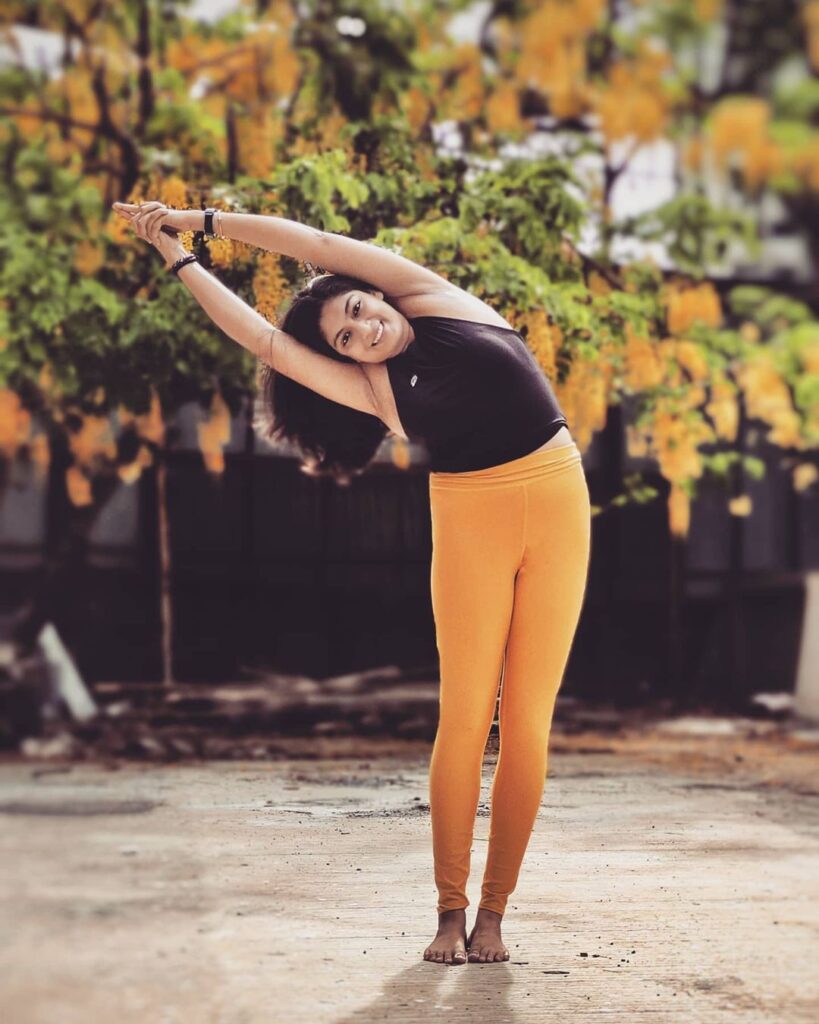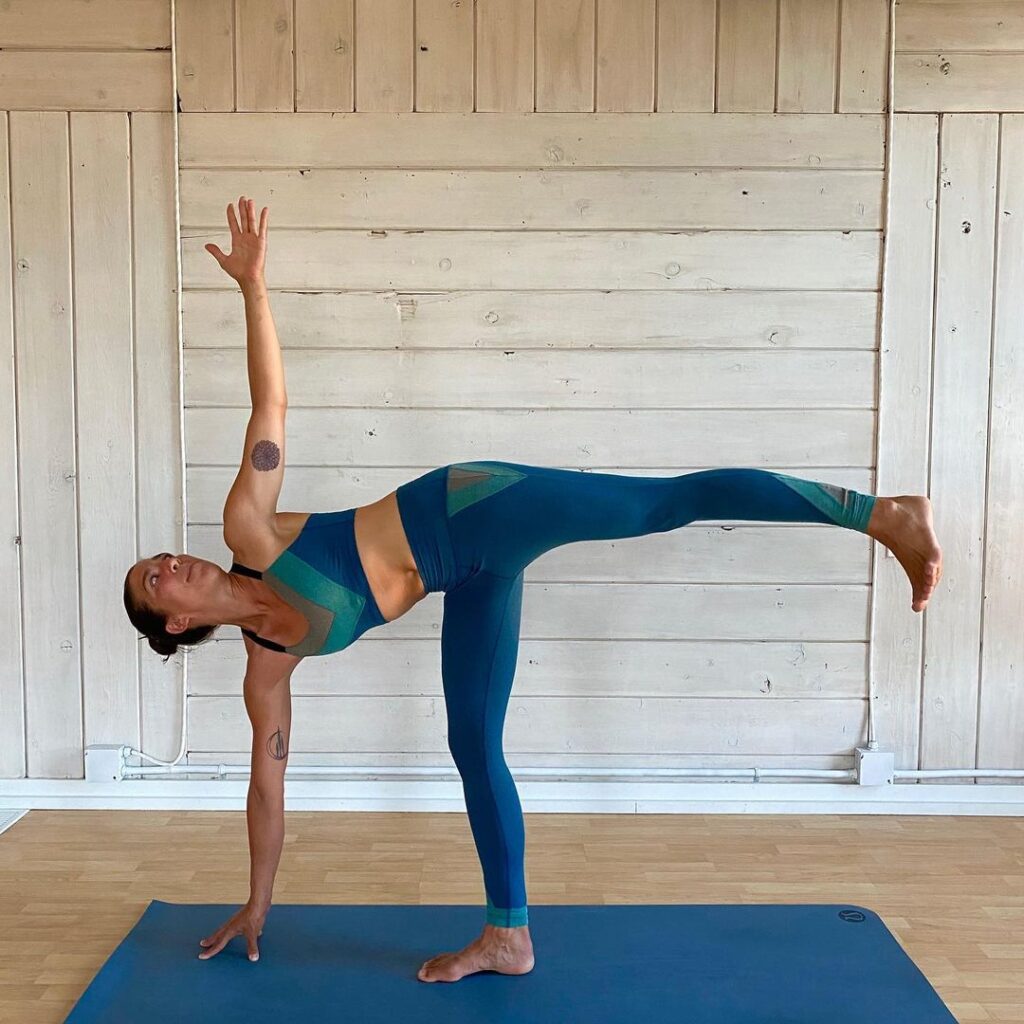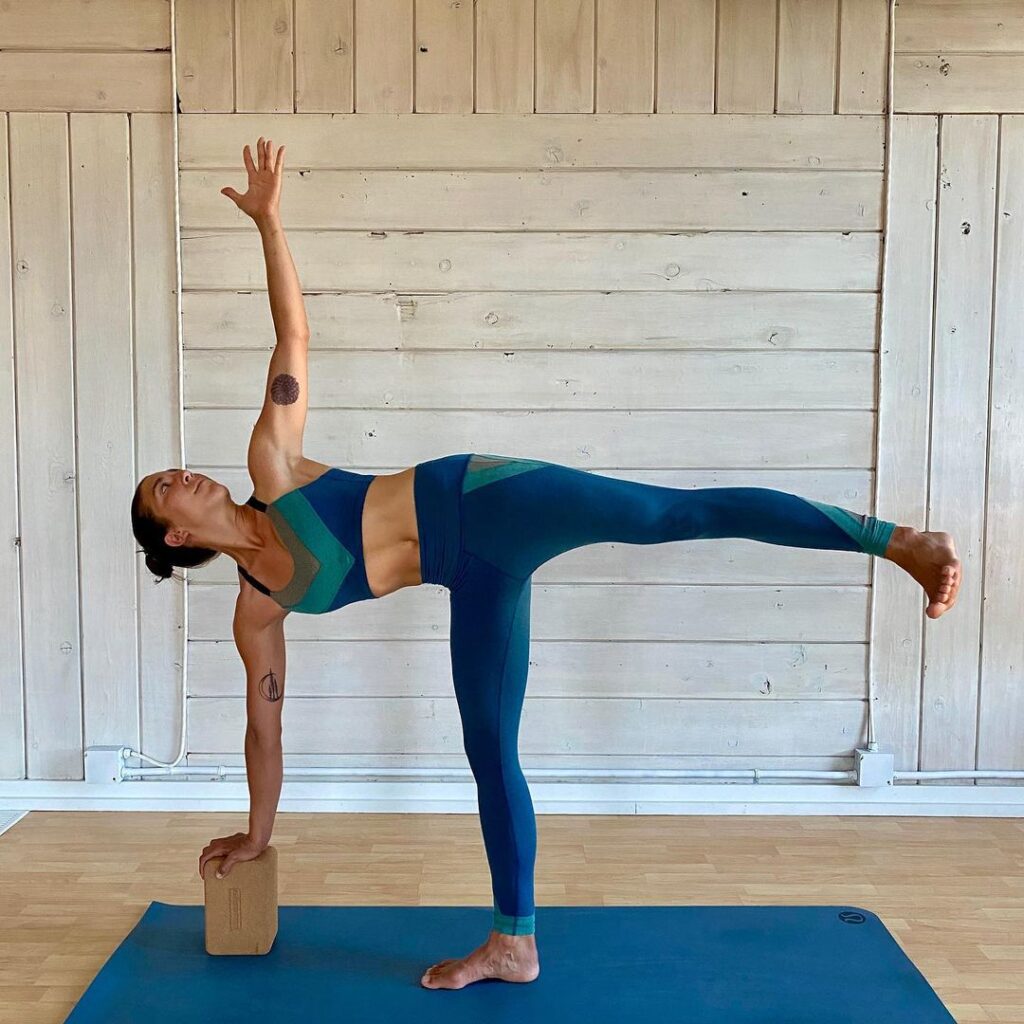Half Moon Pose (Ardha Chandrasana) is a great hatha yoga pose where the lunar energy in the body is enhanced. It strengthens the knees, hips, spine, abdomen and tones the lower region of the spine and the nerves connected with the leg muscles.
Half Moon Pose bends the body in such a way that it looks like a crescent moon. As the body first bends to one side and then to the other, it reinforces how flexible and resilient the whole existence is. If you go both rounds of the Half Moon, you’ll probably go further a second time.
Lunar energies are channeled into this pose, which means that the torso moves towards the floor in this pose, creating a stable balance with a calm mind, which depicts the characteristics of the Moon.
This pose stretches the muscles at the waist and on the sides of the upper body, and trims and tones the waist.
The pose is beneficial for people whose legs are damaged or infected. Along with other standing postures, this yoga pose cures gastric discomfort and menstrual problems.
Meaning
The Sanskrit name for Half Moon Pose, “Ardha Chandrasana”, comes from three words.
- Ardha + Chandra + Asana:
- “Ardha” = “half”
- “Chandra” = “moon”
- “Asana” = “pose or posture”
The two poses are similar in their entire body extension; The Half Moon Pose is like a balance variation of a triangle. There are many modifications available for this pose, making it a suitable balancing pose for beginner and advanced yoga students.
The Sanskrit word “Chandra” is often translated as “moon”, and actually has a more rich meaning. More than just the Moon, Chandra means a brilliant object that glows and shines, a magnificent object that emits light on itself or on its own. In many traditional yoga texts and stories, the Moon signifies one of the two polar energies in the body. The Moon, which has a feminine or dark aspect, is nurturing, calm and receptive.
Information
| Known as: | Ardha Chandrasana, Half Moon Pose |
| Sanskrit name: | अर्धचन्द्रासन |
| IAST: | Ardha chandrāsana |
| Pronunciation: | ARD-uh chan-DRAHS-uh-nuh |
| Total time: | 20 to 30 seconds |
| Level: | Intermediate |
| Drishti: | Over the fingertips; Forward; On floor |
| Chakra: | Swadisthana Chakra, Muladhara Chakra |
| Focus: | Knees, Hips, Chest, Core |
| Counterpose: | Janu sirsasana, Gomukhasana, Prasarita Padottanasana |
| Preparatory Poses: | Supta padangusthasana, Utthita trikonasana, Vrksasana |
| Follow-up poses: | Ardha chandra chapasana, Virabhadrasana II, Vasisthasana |
| Indications: | Menstrual pain, kidney and liver, digestion, osteoporosis, menstrual discomfort, anxiety, exhaustion, balance |
| Contraindications: | Modification for back, or shoulder, or neck injuriese, weak knees, low blood pressure, eye strain, sleepiness, migraine or headache, varicose veins |
Benefits of Half Moon Pose (Ardha Chandrasana)
Half Moon pose that balancing act and strengthening combo is a powerful peak pose and can make you feel like a queen of divine feminine energy, over which the moon rules.
This yoga pose reminds yogis that they know about both parts of their body. The right half represents the Sun (masculine energy) and the left half represents the Moon (feminine energy). Yogis understand the body-mind complex as a combination and balance of these two energies: power and love. These positive energies must be balanced by opposite positive energies in order to bring balance physically and mentally. Within our yoga practice we find balance under the sun and the moon. May our hearts be at peace with the universe.
However the following are the physical and mental benefits of Half Moon Pose (Ardha Chandrasana):
- Physical Benefits:
- Strengthens the arches, ankles, thighs, buttocks, and spine
- Stimulates digestion and circulation
- Tones the kidney and liver
- Increases energy to the spine and low back
- Improves balance and coordination
- Improves circulation
- Opens the chest and hips
- Stretches the hamstrings and calves, groins, shoulders, chest, and spine
- Relieves menstrual discomfort and sciatica
- Mental Benefits:
- Stimulates the mind
- Relieves stress
- Reduces anxiety and depression
- Builds focus
- Develops willpower
Step-by-step Half Moon Pose
1. Half Moon Pose (Ardha Chandrasana) Gentle Variation

Instructions
- Stand tall with your feet parallel and close together and raise both arms overhead, palms facing each other. If it feels comfortable, cross your thumbs.
- Tighten your thigh muscles to lower the knee.
- Create an extension in your spine and slowly and gently bend from the waist to the left.
- Tilt your upper body slightly to the left and look down at your left leg. Make sure there is no strain on your neck.
- Hold on for a few breaths.
- Return your upper body to center. If your shoulders are raised, drop them below your ears.
- Repeat the process on the right side. Do not strain, and hold several breaths.
- Return to center, relax your arms, and repeat the process one more time on both sides.
2. Half Moon Pose (Ardha Chandrasana)

Instructions
- Stand in Tadasana (Mountain Pose) and then do Utthita Trikonasana (Extended Triangle Pose), following the technique described in the pose.
- After attaining Trikonasana (Triangle Pose) on the right side, while exhaling bend your right knee and place your right palm at a distance of about one foot from the right foot and simultaneously bring your left foot near your right foot.
- Stay in this position and take two breaths. Then while exhaling, lift your left leg off the floor, toes pointing up. Stretch your right arm and right leg.
- Place your left palm on your left hip or extend it straight over your head and stretch it upward keeping the shoulders well up. Turn your chest to the left and balance.
- The weight of your body is on your right leg and hip. Your right hand is only a prop to control your balance.
- Stay in this pose for 20 to 30 seconds, breathing deeply and evenly. Then slide your left foot on the floor and return to Triangle Pose.
- Repeat the process on your left side.
3. Half Moon Pose (Ardha Chandrasana) Modification

Practicing Half Moon Pose (Ardha Chandrasana) will strengthen and stretch the entire body. Sometimes it can be difficult for beginners to find balance and correct alignment. Try these simple modifications to find the variation of the asana that works for you:
- If you cannot touch the floor with your lower hand or fingers, place your hand on a block. Start with the block on its highest side. Slowly lower it to the middle, and then at its lowest height as you gain more confidence.
- Beginners can also practice this yoga pose with their back against a wall. This will provide support and reduce any fear of falling as you learn the correct alignment of the pose.
- Beginners can use a wall to learn the correct alignment of leg raises:
- Keep your back to the wall, one foot length away from the wall.
- Keep your fingers on the floor in front of you by tilting your torso forward. Then raise the left leg parallel to the floor.
- Press the sole of your left foot with your toes pointing downward.
- Coming to the half moon with your left foot supported against the wall, slowly rotate your torso and left leg to the left.
- For the greater challenge, raise your lower hand away from the floor and rest on the thigh of your erect leg.
Note: Those who feel weak and tired of standing should only practice Utthita Trikonasana and Utthita Parsvakonasana, as both these poses strengthen the body. Other standing postures should only be done by those who have built up their strength and whose bodies have become elastic.
Precautions and contraindications
- Avoid practicing this asana if you are suffering from migraine or headache, sleepiness, low blood pressure.
- If you have a recent or serious injury to your leg, back, shoulder or arm, you should not do this yoga asana. Under such circumstances it can be painful to perform Half Moon Pose (Ardha Chandrasana).
- If you have weak legs or weak back, consult a doctor before performing this yoga asana.
- Do not lean too far or drop your torso too much. Also, do not lift your leg too much. Keep the body well balanced. Otherwise, you may fall.
- As it is a balanced posture, you may initially fall while doing this yoga asana. Therefore, keep some folded blankets or some soft things around you, so that if you fall, you will not get hurt.
- Do not close your standing knee; Instead, keep it firm.
- Do not overstretch your body. Just stretch the body until you are comfortable, do not force your body to do extra stretches.
- Do this yoga asana on an empty stomach or after 4-6 hours of having a meal.















